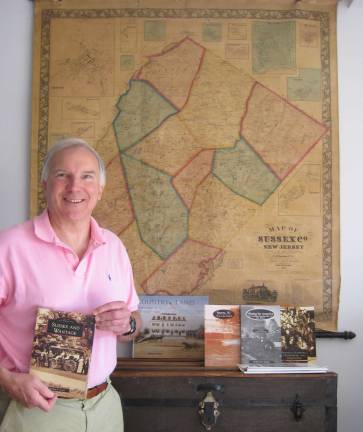Local history told through vintage photos

SUSSEX Dr. Bill Truran has just published a fifth local history book, and like the previous four, this one captures through a collection of vintage photographs Sussex Countys rich past when agriculture and mining dominated New Jerseys northernmost county.
Images of America: Sussex-Wantage, is a 128-page book that Truran, 61, has assembled about two communities that are among the smallest countywide. The book, like all of Trurans previous works, is laden with rich black-and-white photos that the author uses to make his case about olden days when people made do for themselves and even managed to help a county at the same time.
It is published by Arcadia Publishing as part of its Images of America series.
This book, Truran said, covers all of Wantage Township, which includes Deckertown, now Sussex (Borough0; and Beemerville and Plumbsock, among several other hamlets, which is part of Wantage, explained Truran, a professor of engineering management at Stevens Institute of Technology in Hoboken. Deckertown is what Sussex was once officially called until about 1901.
Truran, a lifelong resident of Sussex County, grew up at a time when the legendary Franklin mines were still in operation and in the immediate years afterward when his love of local history began. Some of the photos in this book are from his late grandfather, Sydney Hall, who worked in the Franklin mines, and other photos are from other sources.
Trurans first book was Franklin, Hamburg, Ogdensburg, Hardyston, a 2004 work published also by Arcadia, which is based in South Carolina. That was followed by Sparta: Head of the Walkill in 2005; Mining for America in 2006; and then last years Country Lanes, a series of paintings by Louis Larsen, whose works were available in the earlier parts of the 20th century.
The first and current books were published by Arcadia; the middle three were published by the author himself.
Looking toward the future Like many authors, Truran realizes his work is not just for today, but for posterity as well.
All of its been a large undertaking, but Ive enjoyed doing each one of them, said Truran, who is originally from Franklin. I realize that theyll be around here for many years after Im gone.
Truran works so hard in his off-time on these projects that very often, one thing can lead to another.
I had, as a result of all the other work that Ive done, extra research material that could fill the better part of another book, Truran explained. So I found I had a plethora of information, and I hadnt done anything about that area, so I said to myself, go ahead. I was very happy to see a number of the photographs that were re-discovered after many years, and I was energized by putting some of them together in a sequence.
Learning about the past One of the sequences is how milk (came) about. Theres several photographs of farmers with their cows, and theyre taking their product by horse and wagon to the creameries, Truran added, and then carried again by horse and wagon to peoples doorsteps.
The milk was pasteurized at the creameries, Truran added. One of those local creameries was located in Beemerville, Sussex (Deckertown) and also in Quarryville, which was also part of Wantage. There was also a one located in nearby Unionville, N.Y.
The book is available locally at Sparta Bookstore, where Truran will soon be making an appearance to sign copies. Meanwhile, it can be purchased for $21.99 through Arcadia Publishing at www.arcadiapublishing.com or 888-313-2665.
To reach Truran himself, e-mail him at wrt1@columbia.edu.